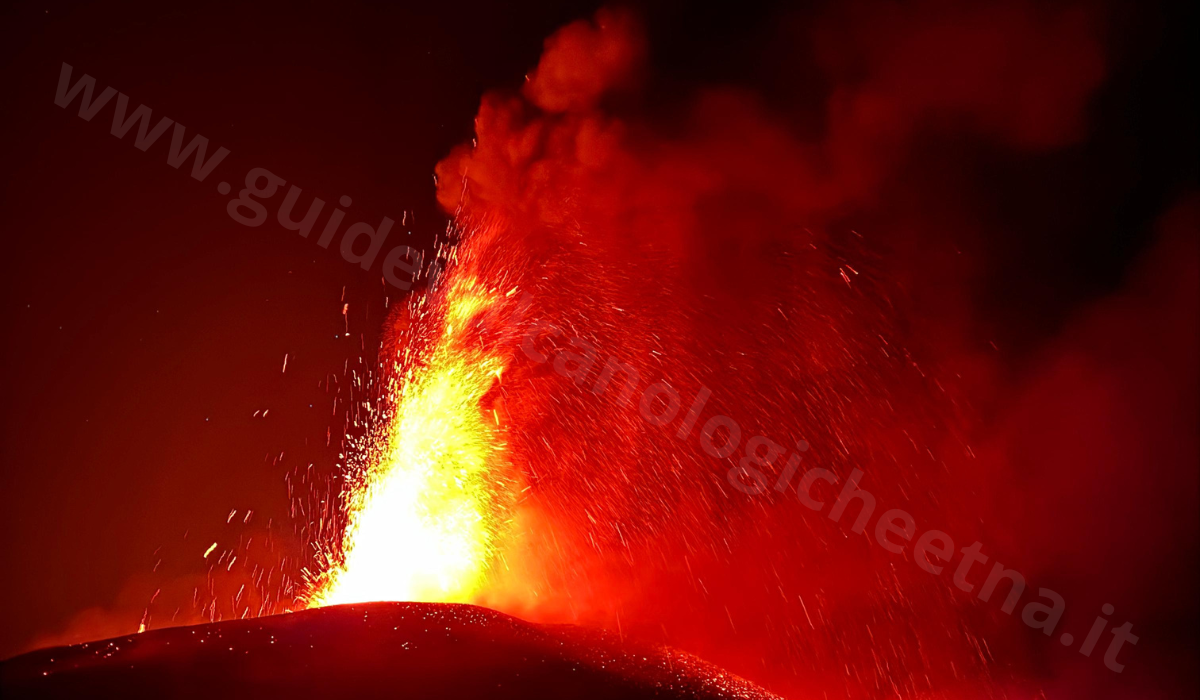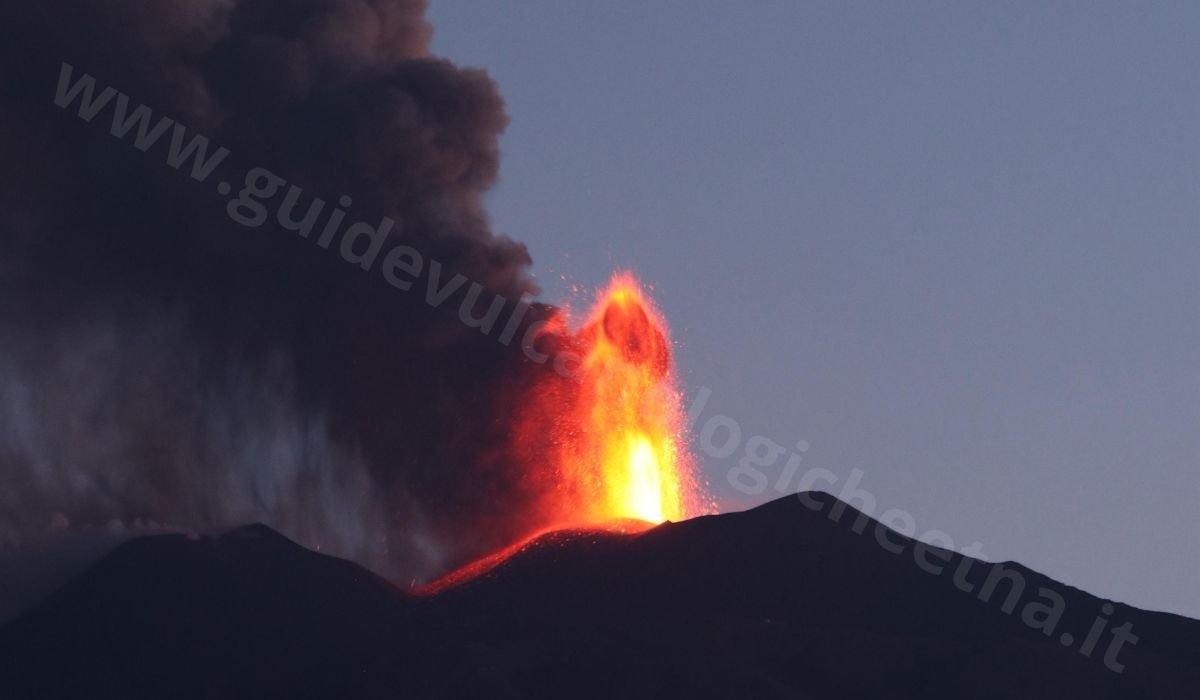Mount Etna Eruptions Chronicle 2024
The Paroxysmal Sequence of Summit Craters
Mount Etna, Europe's most active volcano, experienced a period of intense eruptive activity between June 14 and August 18, 2024. The Central Crater, also known as Voragine (VOR), played a central role in this eruptive phase, involving adjacent craters as well, such as Bocca Nuova (BN) and Northeast Crater (NEC).

The Protagonist Craters
Central Crater (Voragine - VOR)
The main protagonist of the 2024 eruptive sequence, characterized by intense lava fountains and continuous strombolian activity.
Bocca Nuova (BN)
Adjacent crater that hosted the initial lava flows and witnessed the evolution of the most advanced paroxysmal activity.
Northeast Crater (NEC)
Showed intermittent explosive episodes, launching lithic blocks up to nearly 1 km distance during the most intense phases.

Detailed Timeline of Eruptive Events
Onset of Eruptive Activity
Activity at the Central Crater begins with a gradual but constant increase in intensity and frequency of strombolian explosions. These explosions poured lava flows inside Bocca Nuova, keeping the activity confined within this crater for several weeks. The explosions became increasingly frequent and vigorous.
Evolution to Lava Fountain
Starting at 16:15 UTC, the strombolian activity at Central Crater (Voragine) evolved into a lava fountain, producing an eruptive column that reached a height of approximately 4,500 meters above sea level. The eruptive column propagated southeast, causing significant ashfall on several settlements in the southeastern area of Etna, reaching as far as Syracuse and beyond.
The lava fountain activity gradually weakened during the night between July 4 and 5, ceasing completely around 01:50 UTC on July 5. After the fountain ended, strombolian activity continued for about an hour before ceasing completely.
Surveys and Mapping of Vulcanites
On July 5 and 8, drone surveys were conducted to map the vulcanites from eruptive events of July 4 and 7 and update the topography of summit craters.
Technical Survey Data:
Extracrateric flow area: 0.4 × 10⁵ m² with volume of approximately 1 × 10⁵ m³
Intracrateric flow area: 0.6 × 10⁵ m²
Proximal pyroclastic deposit area: 0.8 × 10⁵ m²
Flow front elevation (July 8, 16:00 UTC): 3,016 meters a.s.l.
Peak of Eruptive Activity
The eruption reached a new intensity peak. Lava fountains exceeded 1,000 meters in height and an eruptive column of ash and gas rose up to 10 kilometers into the atmosphere, causing significant disruption to air traffic, including the temporary closure of Catania airport. Lava flows continued advancing, destroying vegetation and threatening agricultural areas.
Activity Decrease
Eruptive activity at the Central Crater began to diminish, ceasing completely around 2 AM. In the following days, before the July 23 lava fountain, ash emissions resumed, followed by intermittent strombolian activity. These emissions indicated a less intense but continuous phase of activity.
Lava Fountain and NEC Explosion Resumption
On the morning of July 23, after a night of intense strombolian activity, a new lava fountain began around 7:45 AM. This event produced a gas and ash column that remained sustained until 12:00 PM, then gradually diminished until completely exhausted.
Subsequently, as occurred after the July 15 event, the Northeast Crater resumed sudden explosions, launching lithic blocks to nearly 1 km distance.
Explosions and Ash Emissions
Eruptive activity continued with explosions and ash emissions from both Voragine and, sporadically, from the Northeast Crater. The emitted ash dissolved in the atmosphere without causing major fallout in surrounding areas.
The Most Powerful Lava Fountain
Eruptive activity reached a new climax with the most powerful lava fountain of the entire paroxysmal series. Incandescent jets exceeded 2,000 meters in height above the crater rim, causing additional lava flows toward the southwestern and western flanks. This event marked (up to this moment) the most intense phenomenon of the paroxysmal sequence.
Final Vulcanite Map (August 4, 2024):
During the following week, the final map of vulcanites related to the August 4 eruptive event was produced. The map was obtained by analyzing thermal infrared images acquired on August 4 via drone by the Cartography and Drone Laboratory, and Sentinel-2 satellite images from August 9.
Formation: A single extracrateric lava field, divided into three main branches that crossed the road at 3,000m elevation at three distinct points, along with an extracrateric reomorphic flow.
Minimum elevations reached:
• Western flow: 2,922 m a.s.l. (lowest elevation)
• Northwestern flow: 3,042 m a.s.l.
• Southwestern flow: 2,988 m a.s.l.
Areas covered:
• Extracrateric flow: 3.7 × 10⁵ m²
• Reomorphic flow: 0.7 × 10⁵ m²
• Proximal pyroclastic deposit: 1.1 × 10⁵ m²
Total volume emitted: 2.7 × 10⁶ m³ (lava flows + pyroclastic deposit)
Average thicknesses: 4 meters (extracrateric and reomorphic flows), 9 meters (proximal pyroclastic deposits)
Renewed Strombolian Activity
On August 12 and 13, Central Crater strombolian activity was characterized by launching of lava shreds along the flanks of the scoria cone of Bocca Nuova. This activity further fueled the eruption, preparing the ground for a new paroxysmal episode.
Last Paroxysmal Event
On the afternoon of August 14, around 18:00 UTC, an intensification of strombolian activity was observed, which gradually evolved into a lava fountain starting from 22:30 UTC. During this phase, lava flows were produced that exceeded the western rim of Bocca Nuova, partially overlapping the lava field formed on August 5.
Bocca Nuova Explosions - End of Cycle
In the early morning of August 18, 2024, two significant explosive sequences occurred at Bocca Nuova. The first explosion occurred at 02:30 UTC, followed by a second at 02:59 UTC, both lasting approximately 4-6 minutes.
These events marked the last significant phase of explosive activity at the Central Crater during the considered period. We will see in the coming days whether the volcano intends to resume eruptive activity or conclude this cycle of episodes characterized by strombolian activity and lava fountains.

